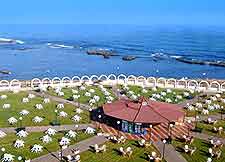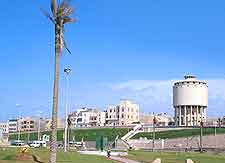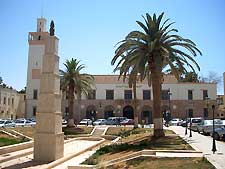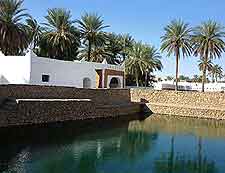Libya Towns, Cities, Locations and Districts
(Libya, LY, North Africa)

Over 90 percent of Libya is covered by desert, so as you may expect, large urban centres are few and far between. Instead, expect to see small oasis towns that seem to rise out of the sand dunes. The development of Libya as a tourist destination is very much in its infancy.
Currently, it is the case that organised tours predominate, with limited opportunity for independent exploration. However, through careful selection of a tour itinerary or guide, it is possible to match your particular interests and needs.

Tripoli
For most visitors, Tripoli offers their first glimpse of Libya. Located in the north-west of the country, on the Mediterranean coast, Tripoli serves both as a capital city and an important port. Worth noting, many people now call this city Western Tripoli, to clearly distinguish it from the city of the same name in Lebanon. Attractions here include the Red Castle, Jamahiriya Museum and the city's fascinating Medina quarter. More information about
Tripoli.

Benghazi
Second only to Tripoli in terms of size and importance, Benghazi has become a popular destination for many tourists. Following heavy bombing during the Second World War, the city was largely rebuilt, making Benghazi a much more modern-looking city than Tripoli. Visitors to Benghazi can enjoy a wealth of white sandy beaches and nearby historic monuments.
Ghat (Gat)
This Tuareg oasis settlement rises impressively from the surrounding sand dunes and marks the entrance to the Acacus desert region. Its Old Town, or Medina, is a maze of narrow alleys, with many partial ruins of buildings evident. At the top of the Old Town is a fortress.

Ghadames (Ghadamis)
Perhaps better known as the 'pearl of the desert', Ghadames is an oasis town with historic roots that go back further than any other Libyan town. Careful preservation means that visitors can still see the town's ancient and rather unique buildings, as well as its narrow alleys. Of particular interest are attractions such as the Jemaa al-Kabir Mosque, the old slave market and the town museum, as well as the popular Ghadames Festival each October and the nearby Zallaf Sand Dunes
Sabha (Sebha)
Sabha is one of the largest oasis towns in the Libyan part of the Saharan Desert. Largely developed as a transport hub for those passing through and headed to other North African countries, Sabha's main claim to fame is that the Libyan leader Mu'ammar Gadhafi was educated here.
Tolmeitha (Tolmeita / Tolometa)
This port town is also known as Ptolemais. Situated between the Mediterranean Sea and the Green Mountains, the town quickly grew in the 6th century BC. Visitors to Tolmeitha today might like to tour the town's places of historic interest, including the gate towers, theatre, stadium, basilica and Roman villa remains.
Tobruk (Tubruq)
The port city of Tobruk is located in north-eastern Libya, overlooking the Mediterranean Sea. Tobruk was once one of Libya's top sea ports and, in 1911, became part of the Italian colonial empire. Most notably, however, Tobruk played an important role in the Second World War. Visitors to the city today can still see evidence of the fierce battles that took place, as well as the cemeteries that commemorate the many soldiers who died here. These include both the Knightsbridge / Acroma Cemetery and the Commonwealth War Cemetery.
 Over 90 percent of Libya is covered by desert, so as you may expect, large urban centres are few and far between. Instead, expect to see small oasis towns that seem to rise out of the sand dunes. The development of Libya as a tourist destination is very much in its infancy.
Over 90 percent of Libya is covered by desert, so as you may expect, large urban centres are few and far between. Instead, expect to see small oasis towns that seem to rise out of the sand dunes. The development of Libya as a tourist destination is very much in its infancy.

